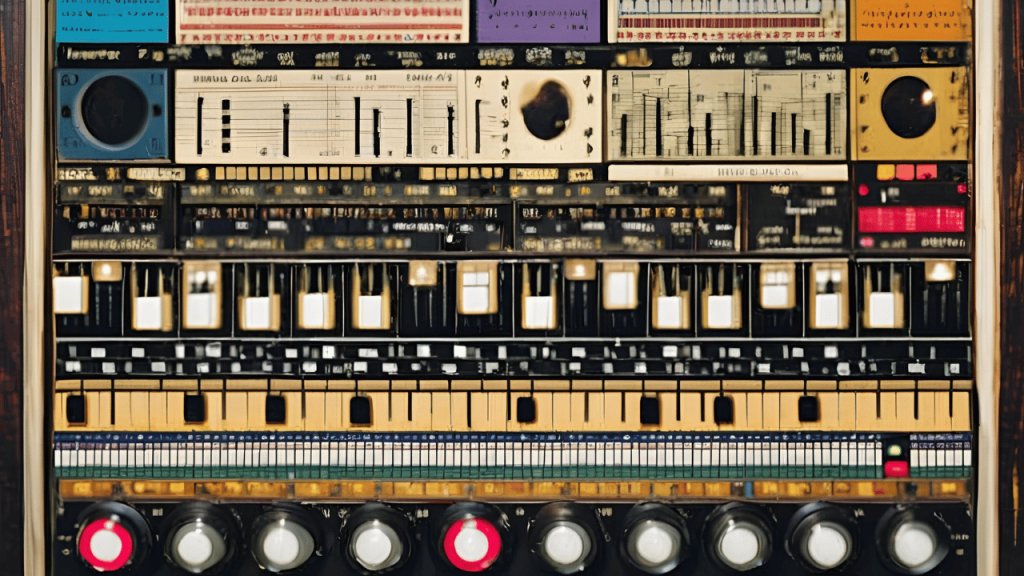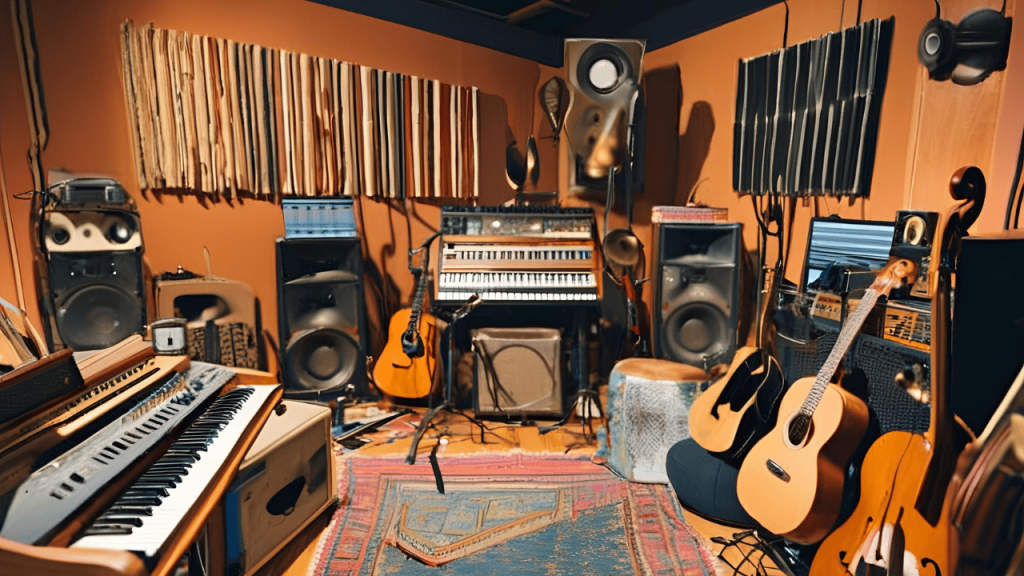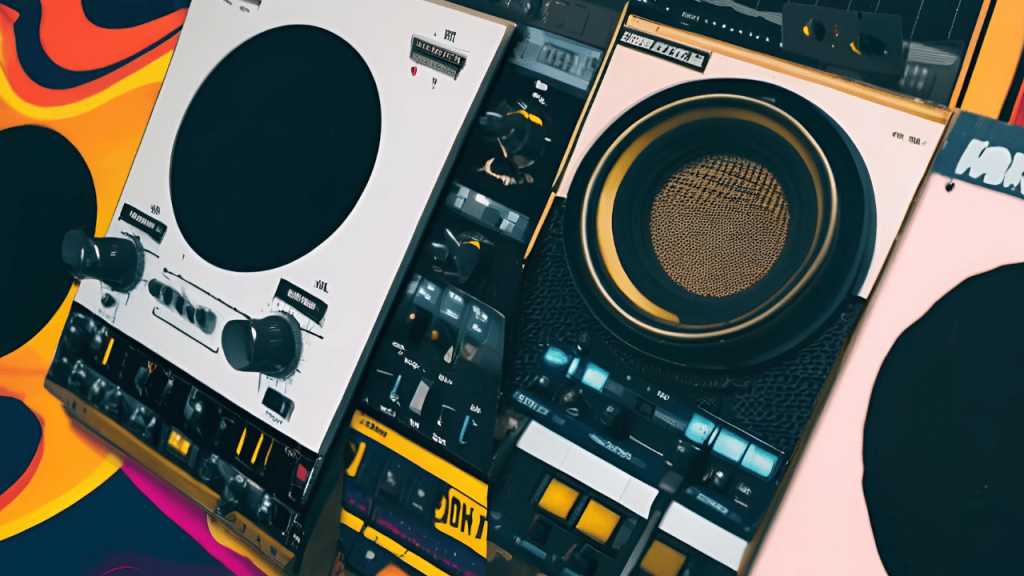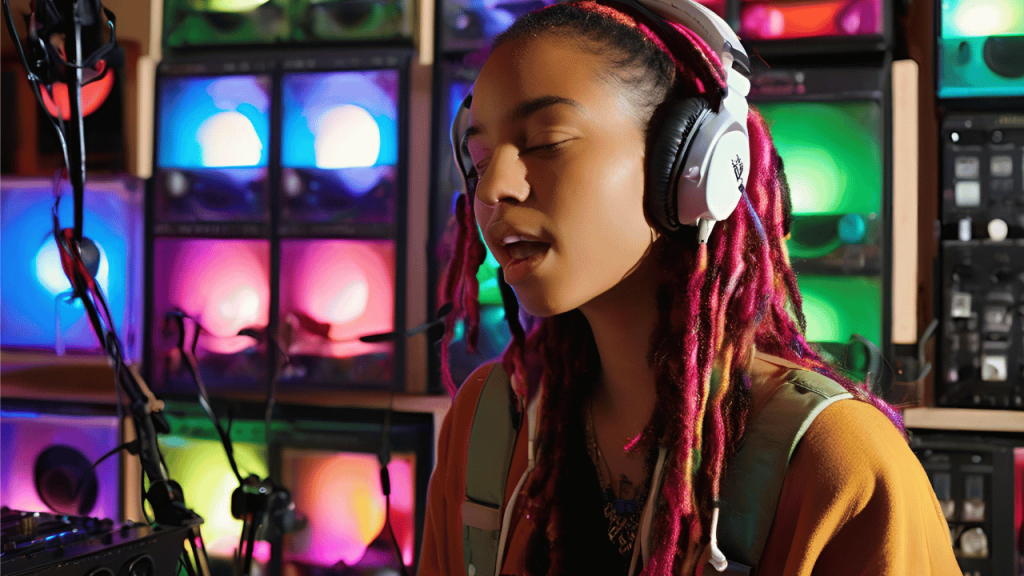Hip hop isn’t just a genre—it’s a cultural movement that has reshaped music, fashion, language, and art across the globe. At the heart of hip hop lies its signature background music, the beats and rhythms that provide the foundation for the genre’s iconic flows and lyrical prowess. But what exactly constitutes hip hop background music, and why is it so pivotal to the genre’s enduring appeal? In this deep dive, we’ll explore the evolution, elements, and impact of hip hop background music, shedding light on the beats that have powered the voices of legends and everyday artists alike.
The Genesis of Hip Hop Background Music

To understand hip hop background music, we must journey back to its origins in the Bronx, New York City, during the late 1970s. Hip hop emerged as a response to the socio-economic challenges faced by African American and Latino communities. It was a form of expression that encompassed not just music, but also dance (breakdancing), art (graffiti), and DJing.
DJ Kool Herc, one of hip hop’s founding figures, pioneered the practice of isolating and extending the breakbeats of funk and soul records. By using two turntables, Herc could loop the instrumental breaks, providing a continuous rhythm that dancers could move to—this was the genesis of the DJ’s role in hip hop and the foundation for background music in the genre.
The Role of the DJ and the Birth of the Beat

The DJ was the original backbone of hip hop. Unlike traditional bands, hip hop DJs created music through the manipulation of records, employing techniques like scratching, looping, and beat juggling. This innovative approach not only provided the beats for rappers to rhyme over but also fostered a sense of community and competition through live performances.
Afrika Bambaataa and Grandmaster Flash further refined these techniques, introducing new elements like the crossfader, which allowed for smoother transitions between tracks, and the use of drum machines and synthesizers, which expanded the sonic palette available to producers.
Key Elements of Hip Hop Background Music

Hip hop background music is characterized by a blend of rhythm, melody, and texture. While the specific components can vary widely, several key elements consistently define the genre’s beats:
1. The Beat and Rhythm
At its core, hip hop relies on a strong, steady beat that anchors the music. The tempo typically ranges from 80 to 115 beats per minute (BPM), providing a groove that supports both the lyrical flow and the dance moves associated with the genre.
- Kick and Snare: The foundation of the beat consists of the kick (bass drum) and snare. The kick provides the low-end thump, while the snare adds sharp, crisp accents. Together, they create the rhythmic backbone that drives the music forward.
- Hi-Hats and Percussion: Hi-hats and other percussion elements add complexity and texture, often incorporating syncopated patterns that enhance the groove. These elements can range from simple closed hi-hats to intricate patterns involving open hats, shakers, and other percussive sounds.
2. Sampling and Looping
Sampling—the practice of taking snippets from existing recordings—and looping these samples is a hallmark of hip hop production.
- Vinyl Sampling: Early hip hop producers heavily relied on vinyl records, sampling breaks, melodies, and rhythms from funk, soul, jazz, and disco tracks. This not only provided a rich tapestry of sounds but also paid homage to the music that influenced the genre.
- Digital Sampling: With technological advancements, digital samplers and software-based production tools have made sampling more accessible and versatile. Producers can now manipulate samples with greater precision, altering pitch, tempo, and adding effects to create entirely new sounds.
3. Basslines and Sub-Bass

A deep, resonant bassline is essential for adding depth and energy to hip hop tracks. Whether through synthesized bass or sampled basslines, this element provides the low-end power that drives the music.
- Sub-Bass Frequencies: These frequencies are felt more than heard, adding a physical dimension to the music that enhances the listener’s experience, especially in live settings.
4. Melodic Elements and Harmony
While rhythm is paramount, melodic elements add richness and emotion to hip hop background music.
- Keys and Synths: Piano, electric piano, and synthesizer lines often play a crucial role, providing hooks and motifs that complement the vocal delivery.
- Orchestration: Strings, brass, and other orchestral elements can add a cinematic quality, creating a more expansive and dynamic soundscape.
5. Texture and Effects
The use of effects and textural layers contributes to the unique atmosphere of each track.
- Reverb and Delay: These effects add space and depth, creating a sense of ambiance and movement.
- Scratches and Foley: Traditional DJ techniques like scratching, along with found sounds and Foley effects, can add an organic, raw quality to the background music.
Evolution of Hip Hop Background Music
Hip hop background music has evolved significantly since its inception, reflecting broader changes in technology, culture, and musical influences.
1980s: The Golden Age of Sampling

The 1980s are often referred to as the “Golden Age” of hip hop, marked by creative sampling and innovative production techniques. Producers like Rick Rubin and Kool DJ Herc laid the groundwork for modern hip hop by experimenting with diverse samples and establishing the role of the producer as a key creative force.
- Breakbeats: Tracks like “Planet Rock” by Afrika Bambaataa and “Fight the Power” by Public Enemy exemplify the era’s emphasis on breakbeats and socially conscious sampling.
- Emergence of the Producer: Figures like Grandmaster Flash and Prince Paul began to gain recognition not just as DJs but as producers, crafting intricate soundscapes that defined the genre.
1990s: East Coast vs. West Coast and the Rise of G-Funk
The 1990s saw hip hop splinter into various subgenres, each with its distinctive background music.
- East Coast Hip Hop: Known for its gritty, sample-heavy beats, artists like Nas, Notorious B.I.G., and Wu-Tang Clan emphasized complex lyricism backed by soulful samples and hard-hitting drums.
- West Coast Hip Hop: Characterized by the smooth, laid-back sounds of G-Funk, pioneered by artists like Dr. Dre and Snoop Dogg, incorporating synthesizers, melodic hooks, and funk-inspired basslines.
2000s: The Rise of Southern Hip Hop and Trap
The new millennium ushered in Southern hip hop’s dominance, with subgenres like Trap gaining immense popularity.
- Trap Music: Originating from the South, Trap is defined by its aggressive 808 drum patterns, rapid hi-hats, and dark, atmospheric synths. Producers like Lex Luger and Metro Boomin have been instrumental in shaping this sound.
- Diversification: The 2000s also saw the fusion of hip hop with other genres, leading to innovative blends like crunk, snap, and alternative hip hop, each bringing unique elements to the background music.
2010s-Present: Digital Revolution and Genre Blending

Advancements in technology have transformed hip hop background music, making production more accessible and enabling unprecedented creativity.
- Digital Production: Software like Ableton Live, FL Studio, and Logic Pro have democratized music production, allowing artists to craft intricate beats from their bedrooms.
- Genre Blending: Contemporary hip hop often incorporates elements from EDM, R&B, and even classical music, resulting in rich, multifaceted background tracks. Artists like Kendrick Lamar, Drake, and Travis Scott exemplify this trend, blending melodic hooks with complex rhythms and diverse instrumentation.
The Impact of Technology on Hip Hop Background Music
Technology has been a driving force behind the evolution of hip hop background music, influencing everything from production techniques to distribution.
Sampling Technology
The development of samplers and digital audio workstations (DAWs) revolutionized how producers create beats. Early hardware samplers like the Akai MPC allowed for more precise control over samples, while modern DAWs offer limitless possibilities for manipulation and layering.
Digital Production Tools
The rise of software synthesizers, drum machines, and virtual instruments has expanded the sonic palette available to producers. Tools like Serum, Massive, and Kontakt enable the creation of unique sounds that were previously difficult or impossible to achieve.
Collaboration and Distribution
The internet has transformed collaboration, allowing producers and artists from around the world to work together seamlessly. Platforms like SoundCloud, Bandcamp, and YouTube have democratized distribution, enabling independent artists to share their music without the need for traditional record labels.
Prominent Producers Shaping Hip Hop Background Music

Behind every great hip hop track is a producer crafting the perfect background music. Let’s highlight some of the most influential producers who have left an indelible mark on the genre.
Dr. Dre
A pioneer of the West Coast sound, Dr. Dre is synonymous with high-quality production. His work on albums like The Chronic and 2001 introduced the world to G-Funk, characterized by melodic synths, deep basslines, and crisp drum patterns. Dre’s meticulous attention to detail and emphasis on sonic clarity have set a standard in hip hop production.
J Dilla
Known for his soulful, sample-heavy beats, J Dilla is revered for his innovative approach to rhythm and texture. His work with A Tribe Called Quest, Slum Village, and his solo projects showcases a unique ability to blend jazz, soul, and hip hop seamlessly, creating background music that is both complex and emotionally resonant.
Kanye West
Kanye West revolutionized hip hop production with his use of orchestral samples, unconventional song structures, and blending of genres. Albums like The College Dropout and My Beautiful Dark Twisted Fantasy feature lush, layered background music that pushes the boundaries of what hip hop can sound like.
Metro Boomin
A key figure in modern trap music, Metro Boomin is known for his dark, atmospheric beats and heavy use of 808s and hi-hat rolls. His collaborations with artists like Future, Drake, and 21 Savage have solidified his reputation as one of the leading producers in contemporary hip hop.
Timbaland
Blending hip hop with R&B and electronic music, Timbaland has crafted some of the most innovative background music in the industry. His distinctive use of unconventional rhythms, vocal samples, and electronic textures has influenced a wide range of artists across multiple genres.
The Art of Beat Making: From Inspiration to Execution

Creating hip hop background music is a nuanced process that blends creativity with technical skill. Let’s explore the typical steps involved in beat making, from initial inspiration to the final product.
1. Inspiration and Conceptualization
Every great beat starts with an idea. Producers draw inspiration from various sources—other music, personal experiences, or even visual art. This stage involves conceptualizing the mood, tempo, and overall vibe of the track.
- Listening and Analysis: Studying influential tracks and dissecting their elements helps producers understand what makes a beat effective.
- Mood Boards and Samples: Creating a collection of samples, whether they’re short audio clips or full-fledged melodies, can serve as a foundation for the beat.
2. Laying Down the Rhythm
The backbone of any hip hop track is its rhythm section.
- Drum Programming: Using drum machines or software like Ableton Live’s Drum Rack, producers craft the kick, snare, and hi-hat patterns and if you want to search for a huge amount of royalty free rap beats you can find them here. This step sets the tempo and groove of the track.
- Layering: To add depth, multiple drum sounds are layered. For instance, combining a punchy kick with a sub-bass layer enhances the low-end presence.
3. Crafting the Melody and Harmony
Once the rhythm is in place, producers add melodic elements to complement the beat.
- Sampling: Digging through vinyl or digital libraries to find the perfect sample is a common practice. This could be a soulful vocal snippet, a jazzy horn line, or a melodic riff.
- Original Composition: Some producers prefer to create original melodies using synthesizers or live instruments, providing a unique flavor to the background music.
4. Bassline Development
A strong bassline is crucial for adding groove and depth.
- Synthesized Bass: Using virtual instruments or hardware synthesizers, producers design bass sounds that complement the kick drum.
- Sub-Bass Layers: Enhancing the bass with sub frequencies ensures the track has the necessary low-end power, especially important for genres like trap.
5. Adding Textures and Effects

To make the beat more engaging, producers incorporate various textures and effects.
- Reverb and Delay: These effects add space and dimension, making the sounds feel more expansive.
- Automation: Adjusting parameters over time, such as filter sweeps or volume changes, keeps the background music dynamic and evolving.
6. Arranging and Structuring
A well-arranged track maintains the listener’s interest from start to finish.
- Intro, Verse, Chorus, Bridge: Structuring the beat to accommodate different sections of a song ensures that the background music supports the lyrical flow.
- Transitions: Smooth transitions between sections, using techniques like risers, drops, or filter changes, help maintain cohesion.
7. Mixing and Mastering
The final steps involve polishing the track to ensure all elements blend seamlessly.
- Mixing: Balancing levels, EQing individual tracks, and applying compression ensures clarity and cohesion.
- Mastering: The final polish that prepares the track for distribution, ensuring it sounds great on all playback systems.
The Symbiotic Relationship Between MCs and Beats
In hip hop, the relationship between the MC (rapper) and the beat is inherently symbiotic. The background music not only provides a rhythmic foundation but also influences the mood, pace, and emotional tone of the lyrics.
Flow and Rhythm
A well-crafted beat complements the rapper’s flow—the rhythm and pattern of their delivery. Producers often tailor the beat’s tempo and groove to match the desired vocal cadence, ensuring that the MC’s performance feels natural and compelling.
Emotional Resonance
The background music sets the emotional tone of the track. A melancholic melody paired with introspective lyrics creates a different impact than an upbeat, energetic beat accompanying party anthems. This interplay allows artists to convey complex emotions and narratives effectively.
Creative Collaboration
Many iconic hip hop tracks are the result of close collaboration between producers and MCs. This partnership can lead to innovative sounds and styles, as each artist brings their unique perspective to the table. Examples include the collaboration between Kanye West and Jay-Z, or Dr. Dre and Snoop Dogg, where the synergy between the artist and producer creates timeless music.
The Cultural Significance of Hip Hop Background Music

Beyond its musical elements, hip hop background music holds significant cultural importance. It serves as a voice for marginalized communities, a platform for storytelling, and a catalyst for social change.
Narrative Storytelling
Many hip hop tracks use the background music to enhance the storytelling aspect of the lyrics. The beat can underscore the narrative, emphasizing key moments and emotions. This combination allows artists to convey powerful messages and connect deeply with their audience.
Social Commentary
Hip hop has long been a medium for social and political commentary. The background music often reflects the gravity of the subject matter, whether it’s addressing systemic racism, economic disparities, or personal struggles. By setting an appropriate tone, the beat amplifies the impact of the message.
Community and Identity
Hip hop background music fosters a sense of community and shared identity. From block parties and underground clubs to global concerts, the beats bring people together, transcending geographic and cultural boundaries. This unifying power has been instrumental in hip hop’s rise as a global phenomenon.
The Future of Hip Hop Background Music
As hip hop continues to evolve, so too does its background music. Emerging technologies, shifting cultural landscapes, and innovative production techniques are shaping the future of the genre.
Artificial Intelligence and Machine Learning
AI-driven tools are beginning to influence hip hop production. From automated beat making to intelligent sampling, these technologies can assist producers in creating complex, innovative beats more efficiently. While AI won’t replace the creative genius of human producers, it offers new possibilities for experimentation and creativity. A great example of this is Suno where songs can be created in full by AI. Artist create lyrics for it in tool like ours found here then used in Suno to create the beats.
Virtual Reality and Immersive Experiences
The integration of virtual reality (VR) and augmented reality (AR) into music production and consumption is poised to revolutionize hip hop. Producers can create immersive soundscapes that interact with visual elements, offering listeners a more engaging and interactive experience.
Global Influences and Fusion
As hip hop continues to absorb influences from around the world, its background music becomes increasingly diverse. Producers are blending traditional instruments and rhythms from various cultures with classic hip hop elements, resulting in rich, hybrid sounds that push the genre forward.
Sustainability and Ethical Production
With growing awareness of environmental and ethical issues, producers are exploring sustainable methods of music production. This includes using eco-friendly equipment, promoting fair sampling practices, and supporting local communities through music initiatives.
The Undeniable Power of the Beat

Hip hop background music is more than just a backdrop for rhymes and rhythms—it’s the heartbeat of a genre that has continually reinvented itself while staying true to its roots. From the breakbeats of the Bronx to the trap rhythms dominating global charts today, the evolution of hip hop background music mirrors the resilience and creativity of its culture.
Producers and artists alike understand that the beat is not merely a foundation but an integral character in the storytelling process. It’s the driving force that energizes performances, the emotional undercurrent that deepens lyrical content, and the cultural thread that weaves communities together.
As technology advances and cultural boundaries blur, hip hop background music will undoubtedly continue to innovate, inspiring future generations to express themselves and push the limits of what music can achieve. Whether you’re a seasoned producer, an aspiring MC, or simply a fan of the genre, appreciating the complexities and nuances of hip hop background music enriches your understanding of this powerful and dynamic art form.
In the end, it’s the beats—the unseen, often unsung heroes of hip hop—that truly make the genre resonate, proving that sometimes, the best stories are told not just with words, but with rhythm and sound.

Comments are closed.